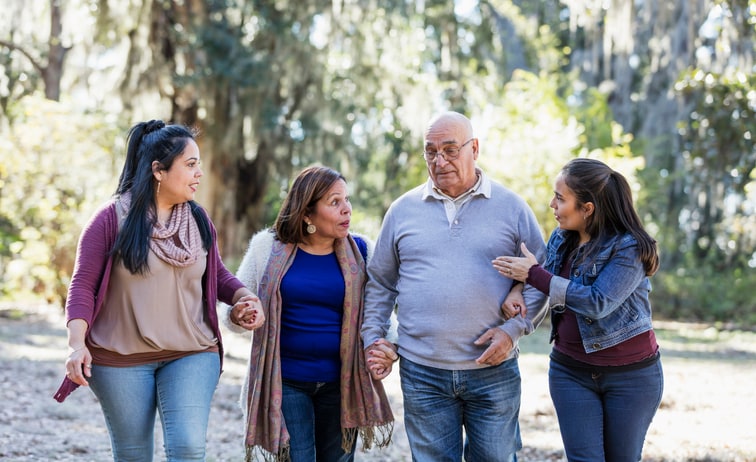A senior’s ability to get a COVID-19 vaccine currently depends on where they live, their health, age and occupation. Many in long-term care facilities have already been fortunate enough to roll up their sleeves for their first dose.
But, as COVID-19 vaccines rollout across the country, many in the 65 and older crowd (and their caregivers) continue to have questions about their place in line.
Here’s a look at what’s known, what’s not and what lies ahead for 2021.
When will seniors and their caregivers get the vaccine?
Nursing home residents and staff make up more than 40% of all COVID-19 deaths, according to an analysis from Kaiser Family Foundation, and are therefore very high on the list for vaccine distribution.
Right now, individual states and territories are working on the specifics of how the limited supply of each vaccine will be distributed. Their overarching guide is a phased vaccine rollout developed and recently updated by the Centers for Disease Control and Prevention (CDC)’s Advisory Committee on Immunization Practices (ACIP) after rising COVID-19 hospitalizations and deaths among adults 75 years and older.
Here’s how the allocation breaks down:
-
Phase 1a. Healthcare personnel and long-term care facility residents.
-
Phase 1b. Persons 75 years and older and frontline essential workers.
-
Phase 1c. Persons 65–74 years old, persons 16–64 years old with high-risk medical conditions and other essential workers.
-
Phase 2. All persons 16 years and older not previously recommended for vaccination.
The recommendations above were made official and published in the CDC Morbidity and Mortality Weekly Report (MMWR) on December 22. However, the exact length of each phase is uncertain and may vary on distribution logistics and vaccine availability.
The majority of states are still developing criteria for subsequent Phase 1 prioritization, according to a December report from Kaiser Family Foundation. Notably, there are already some differences from ACIP’s preliminary framework. For example, Alabama, Delaware, Florida, Maryland, North Carolina and Tennessee each prioritize those 65 and older and those with high risk medical conditions over non-health essential workers; North Carolina and Tennessee prioritize those with high risk medical conditions over those ages 65 and older.
In South Florida, people 65 and older can now get the COVID-19 vaccine, although finding a place offering appointments can be difficult. In some parts of Florida, seniors waited in long lines the first week of their “first come, first serve” rollout, with some even camping out overnight in lawn chairs to receive the vaccine.
I'm encouraged to see that 400 @FLGuard members are assisting in distributing the #CovidVaccine.
But, as @HealthyFla websites & phone lines are overwhelmed, and we continue hearing reports of seniors sleeping in their cars outside of public health centers, people deserve better.
— Commissioner Nikki Fried (@NikkiFriedFL) January 6, 2021
Those who are 65 and older, who have chronic illnesses and who are healthcare providers and other critical staff should be among the first to receive the vaccine, advised Dr. Francis Collins, director of the National Institutes of Health Collins in a November AARP Coronavirus Tele-Town Hall.
The government’s Operation Warp Speed invested in the manufacturing of both vaccines before even knowing if they would work and previously stated 40 million doses of the vaccine would be available by the end of December. However, the CDC COVID data tracker reports only about 4.8 million people have gotten the vaccine in the United States as of January 5, 2021.
Vaccine trials from other drugmakers are still underway, and once they conclude, Collins said, they will also need to go through the same review process by the Food and Drug Administration (FDA) before an Emergency Use Authorization (EUA) is granted and manufacturing and distribution plans are finalized.
“While the vaccines offer long-term hope, we are still in a near-term crisis,” says Dr. Brian Williams, co-director of the surgical intensive care unit at the University of Chicago. “Each of us must remain vigilant about minimizing our individual roles in spreading the virus.” He recommends COVID-19 precautions such as continuing to wear a mask, wash your hands, keep social distance and avoid large gatherings.
Does race and immigration status factor into who gets the vaccine first?
The national phased approach for distribution doesn’t specifically call out race and/or immigration status among the subpopulations at risk; however, some states have spoken up about the issue. In New York, for example, Governor Andrew Cuomo has said his state will not tolerate inequity in COVID vaccine distribution. On Twitter, he wrote, “Black and brown communities that were first on the list of who died cannot be last on the list of who receives the vaccine.”
Williams agrees with viewing vaccine distribution from a lens of health equity. “We cannot leave the ‘have-nots’ behind as the surge peaks,” he says. “We know 37% of volunteers in the Moderna vaccine trial came from communities of color. Those same vulnerable communities must be prioritized to receive the vaccine when it’s released.”
We also know nearly 45,000 undocumented immigrants are working as nursing assistants and nearly 30,000 are working as home health aides, according to research conducted by the New American Economy, a bipartisan research and advocacy organization. Vaccination for these frontline healthcare workers is also essential in helping reduce the risk of infection among our nation’s seniors.
Where will seniors be able to get the COVID-19 vaccine?
There will eventually be widespread distribution of the vaccine to areas like CVS and Walgreens pharmacies. The best thing you can do right now is get in touch with your or your senior loved one’s local pharmacy and see if they will be one of the ones receiving a vaccine.
“Many local physicians are also receiving them – even if you are in a rural area,” Dr. Anthony Fauci, director of the National Institute of Allergy and Infectious Diseases Fauci shared during his AARP interview. “But physicians throughout the country are not uniform in what their approach is to their patients, so you should not count on your physician calling you up and saying, ‘You’re a person who should be getting the vaccine.’ What you need to do is to take that upon yourself.”
Remember, recipients need two doses of the vaccine spaced three or four weeks apart. Pharmacies and doctors’ offices are working on systems to track which specific vaccine you or your loved one received and make sure a second dose is available where and when it’s needed.
Will the COVID-19 vaccine be covered by Medicare?
Yes. The Centers for Medicare and Medicaid Services released a plan ensuring all Americans – including the nation’s seniors – have access to the COVID-19 vaccine at no cost. (It’s funded by taxpayers.) The vaccine will also be free of charge to those in long-term care facilities like nursing homes, assisted living facilities, residential care homes and adult family homes.
Although there may be no out-of-pocket cost for the vaccine itself for most people, there are plenty of other considerations for seniors to think about.
-
Transportation challenges.
-
Time off work.
-
Interactions (if any) with existing medication and treatment.
-
Potential crowds, wait time and accessibility at the vaccine administration location.
-
Remembering where and when to go back for the second dose.
Vaccinating the some 2 million homebound, at-risk seniors may be difficult, but it isn’t impossible if states look at fee-for-service Medicare records (e.g., recipients of Medicaid home and community-based services and those in managed care plans such as Medicare Advantage, Special Needs Plans and Program of All-Inclusive Care for the Elderly).
Will the vaccine be as effective on seniors? Will it be safe for those with co-existing conditions?
The benefits of vaccination are believed to outweigh possible risks. All COVID-19 vaccines were tested in clinical trials involving tens of thousands of people. In Pfizer’s phase III trial, 48% of its enrollees were between the ages of 56 and 85 while 23% of Moderna’s trial participants were age 65 or older.
Research on the vaccine’s safety and efficacy was published in the peer-reviewed New England Journal of Medicine.
“Both of these COVID-19 vaccines seem to generate just as good antibodies in people over 65, as in people in their 20s,” said Collins. “We are looking pretty good here in being able to say this is really going to work for older people. To see 95% efficacy in both vaccines is incredibly reassuring, exciting and promising for the future.”
Collins adds that because the vaccine is not a live virus, there does not seem to be a risk for them in those who are immunocompromised due to cancer treatment. “There’s nothing about either of these vaccines that could possibly cause an infection,” he explained. “Basically, they are just causing the body to synthesize a little bit of a coat protein. So there’s no risk of making somebody ill from the vaccine itself.”
Still, there are many questions remaining about those who are both older and immunocompromised. More research is needed on specific subpopulations.
What about the flu vaccine?
People 65 years of age and older are at greater risk of serious complications from the flu compared with young, healthy adults. For older adults, getting the flu often leads to a hospital stay, and no one wants that in the middle of a pandemic, which means it’s more important than ever for older adults to get a flu vaccine.
Fauci says flu shots are now available in virtually all the pharmacies. “We had recommended that people get their flu shots before the end of October, but it’s not too late at all to get your flu shot now, and I strongly recommend you do,” he notes.
After all, when the vaccine for the COVID-19 vaccine is available in your community, everyone will want to be doubly protected from the flu and from the coronavirus.


